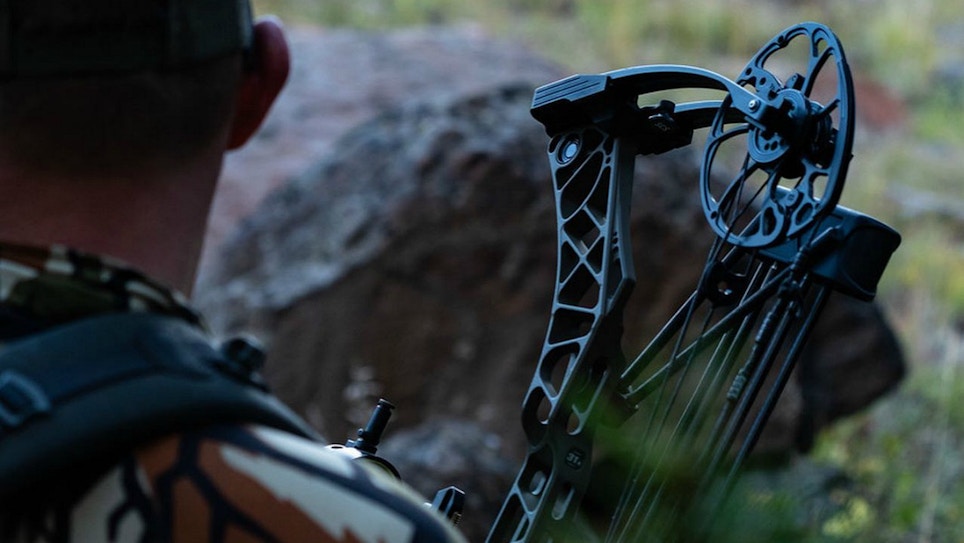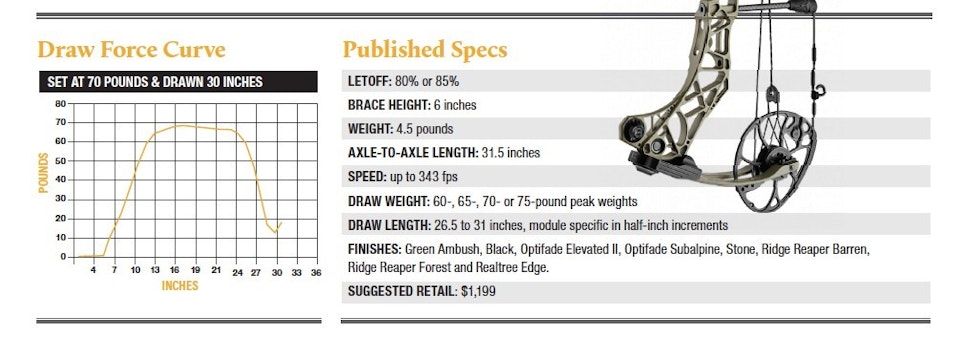Mathews’ reputation for creating bows with a smooth, smile-inducing draw cycle has remained untarnished since it popularized the single-cam bow back in the early 1990s. The industry-wide trend in recent years has been the development of increasingly smooth-shooting bows, and the best ones achieve that while maintaining relatively high speeds. I will cut to the chase and suggest right now that the Mathews VXR has taken that trend a step farther.
That is not to say that it’s a radical departure from its predecessors. It shares some of the better design features of the Triax and last year’s popular Vertix. But with a tweak here, a change there, an improvement elsewhere, it matches the 343 fps speed of the Vertix while being just a little smoother, a little quieter, and even more dead in the hand.
At its heart is Mathews’ Crosscentric cam system, featuring a partially concentric string payout that contributes to the smooth draw cycle while maintaining level nock travel. I could take up all our space discussing this cam system. Instead, I’ll simply point out that Switchweight technology allows shooters to change draw length and even the range of draw weight without changing limbs, and a unique system of spacers on either side of the cam allows shooters to tune the bow without twisting cables or moving the rest off-center shot. The ability to change the draw weight with differing mods is not one that every bowhunter will take advantage of. It does allow a hunter who also does indoor target shooting to switch weights between target shooting and hunting.
Also retained from previous models is the True Center design, which puts the nock at the vertical center of the bow, along with Mathews Harmonic Dampers and monkey tails. The removable Engage grip is back as well, as is the integrated Ultra-Rest which mounts on a dovetail at the back of the riser for a super-solid, virtually unmovable rest — a nice feature I could have used on a recent Texas hunt when a hard bump while hauling my bow into a treestand nocked the rest entirely out of position.
What’s new, among other features, is a longer riser. Significantly, the riser is longer in proportion to axle-to-axle length than is the case for most bows, a quality achieved in part by more parallel limbs. The result is a bow with a steady hold like a target bow while still being relatively maneuverable in a hunting situation. The riser also offers a redistribution of weight to make it less top-heavy. It’s caged top and bottom, but larger cutouts on the top puts relatively more weight on the lower part of the riser for noticeably better balance. That is particularly significant given the True Center technology, which puts the grip below the vertical center of the bow.
The front and back stabilizer bushings have been made a little stouter on the VXR, which (theoretically, at least) should make for marginally less noise and vibration. The limbs, as previously mentioned, are more parallel on the VXR, and this probably contributes to efficiency and reduced hand shock. Also new this year is the optional Silent Connect System, an accessory that allows for quickly and quietly attaching a Mathews bow sling or haul rope to the bow.
In terms of fit and finish, there were no visible flaws of any kind on the black test bow. Logos are understated and crisp and pop out nicely against the black finish, which easily passed the scratch test. The integrated rest, in addition to its enhanced stability, does contribute to a sleeker overall look for the bow.
Since the test bow came with an Ultrarest Integrate MX, which is essentially the same as our standard test rest with a different mount, I tested the bow with this accessory. Sight and stabilizer mounted quickly. Limb bolts were reasonably snug but turned without resort to a vice or tools other than a hex wrench, and did not chatter, stick, or slip. Tuning took about 15 minutes.
Mathews VXR 31.5
At 4.5 pounds, this cannot be called a lightweight bow. As previously mentioned, it is well balanced. The weight, plus the balance, and riser length, contribute to an exceptionally steady hold at full draw. The draw cycle is very smooth and comes back to a solid wall with a good valley. At the shot, the bow pops forward slightly into a loose grip with no discernible vibration. I removed the stabilizer and felt no significant difference and would probably hunt this bow without one. It’s even quieter than last year’s extremely quiet Vertix.
There was a time, and not so long ago, when bowhunters had to choose between a bow that was pleasant to shoot or one that offered the flat-shooting, high-kinetic energy advantages of a speed bow. A bow like the VXR makes the case that this is a choice bowhunters no longer have to make.
How We Test
- Each bow is carefully inspected out of the box for fit and finish and for any visible defects in workmanship. Axle-to-axle length, brace height, mass weight and draw length are measured and compared with stated specs. Minor discrepancies in draw length are corrected or noted.
- A QAD UltraRest is installed, and each bow is equipped with a TruGlo sight, a TruGlo stabilizer, a G5 1/4-inch Metapeep and a D-loop. Test arrows are Carbon Express Maxima Red arrows at weights of 385 and 440 grains, fletched with Bohning Blazer vanes and fitted with QAD Tune-A-Nocks. Peak draw weight is established, and draw force curves, along with letoff, are determined using an Easton Bow Force Mapping System.
- Using a Spot-Hogg Hooter Shooter bow-shooting machine and a ProChrono chronograph, arrow speed and kinetic energy are measured at point of launch and at 20 yards.
- Sound is measured with an NM102 Sound Level Meter with mic positioned 3 feet in front of the bow and 18 inches under the arrow flight path.
- All bows are pressed on a Buckeye Archery Solutions Bow-A-Constrictor press.









